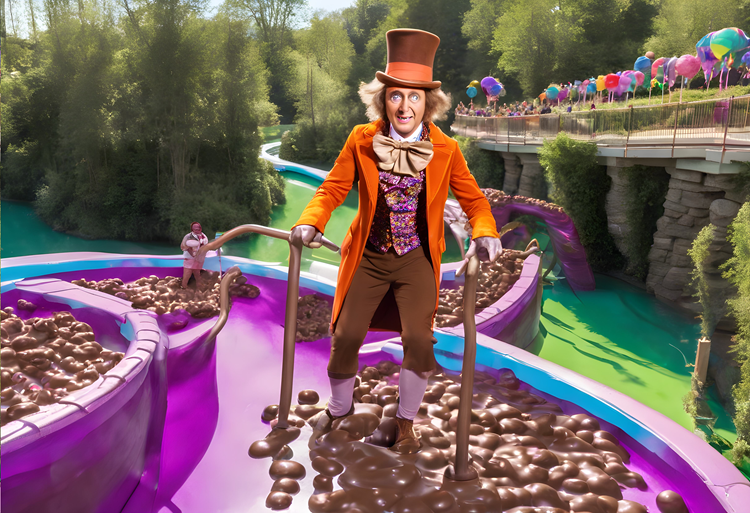Customers decry wonky Wonka experience
February 28, 2024 by DarcieThe easy access to AI image generators have made it almost absurdly easy to get lifelike renditions of scenes that have not and will not ever exist. I’ve seen dreamy “libraries” and even entire “houses” rendered by AI tools like Midjourney and others that were – at first glance – convincingly real. All you need is a prompt and the algorithm does the rest. Recently, parents and their children were drawn in by such imagery to what was billed as a “Willy Wonka experience” in Glasgow. The promotional materials, created using AI, depicted a wondrous event with images of a magical landscape in a kaleidoscope of colors reminiscent of a high-budget film set.

However, when the families arrived they found a mostly bare warehouse with cheap plastic props and a small bouncy house. Social media posts of what was promised versus what was delivered illustrated the stark contrast between the promise and the product. It was so bad that someone called the police! The event organizers ended up apologizing and refunding the ticket price, but that does not completely make up for the disappointment those children felt (ironically, a fairly accurate parallel of what happened in the original story). I suppose the moral of this tale is that you can’t believe everything you see in promotional materials, especially now that entire scenes can be conjured in seconds.
To show how easy it is to make this kind of promo, I entered a prompt of “Willy Wonka experience chocolate river Oompa Loompas ” into a free AI image generator, and what I received a few seconds later is the image in this post. Like many AI generated images, if you don’t look too closely it isn’t half bad – a whimsical image that evokes the fantasy of the original book and movie. Upon closer inspection, however, the details are unrealistic, odd, and in my opinion, downright disturbing (the eyes!).
While we usually use recipe images from the EYB Library or photographs we take ourselves to illustrate EYB blog posts, we have occasionally purchased rights to use a stock image. One company we have used for this purpose has been promoting – nay, pushing – their new AI image generator for several months, but I have not (and will not, save for this post), use the tool because I would rather pay a real person for a quality image than use a tool that makes it harder for photographers to make a living, even if it does save a few bucks. The same goes true for AI copy in blog posts, which as I have mentioned before, is not something EYB is interested in using. We think our Members deserve better than a word salad assembled by a bot or a creepy image designed by AI. The downside risk for Members is that they must occasionally endure bad puns in blog titles like this one. That’s a small price to pay, don’t you think?
Categories
- All Posts (6940)
- Antipasto (2135)
- Author Articles (247)
- Book News (935)
- Cookbook Giveaways (983)
- Cookbook Lovers (257)
- Cooking Tips (109)
- Culinary News (299)
- Food Biz People (552)
- Food Online (791)
- Holidays & Celebrations (272)
- New Cookbooks (149)
- Recipes (1500)
- Shelf Life With Susie (231)
- What's New on EYB (133)
Archives
Latest Comments
- eliza on What foods do you look forward to the most for each season?
- kmwyman on Rooza by Nadiya Hussain – Cookbook Review and Giveaway
- Maryd8822 on The Golden Wok – Cookbook Giveaway
- Dendav on Danube Cookbook Review and Giveaway
- sanfrannative on Rooza by Nadiya Hussain – Cookbook Review and Giveaway
- darty on Danube Cookbook Review and Giveaway
- Atroyer7 on Danube Cookbook Review and Giveaway
- demomcook on What foods do you look forward to the most for each season?
- demomcook on Danube Cookbook Review and Giveaway
- Darcie on How cookbooks can help build resilience